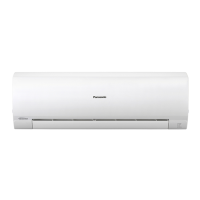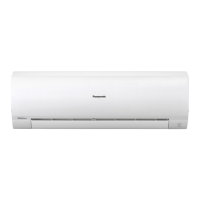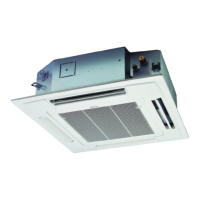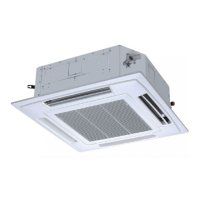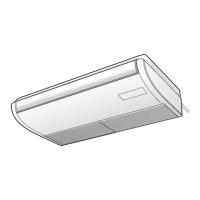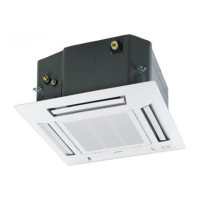35
Taping the fl are nuts
Cover up the tubing connections with the supplied flare
insulator. Then fasten the insulator at both ends with the vinyl
clamps (field supply).
Insulation material
The material used for insulation must have good insulation
characteristics, be easy to use, be age resistant, and must not
easily absorb moisture.
Never grasp the drain or refrigerant connecting outlets
when moving the unit.
CAUTION
After a tube has been insulated, never try to bend it into
a narrow curve because it can cause the tube to break or
crack.
5-4. Taping the Tubes
(1) At this time, the refrigerant tubes (and electrical wiring if
local codes permit) should be taped together with armoring
tape in 1 bundle. To prevent the condensation from
overflowing the drain pan, keep the drain hose separate
from the refrigerant tubing.
(2) Wrap the armoring tape from the bottom of the outdoor
unit to the top of the tubing where it enters the wall. As you
wrap the tubing, overlap half of each previous tape turn.
(3) Clamp the tubing bundle to the wall, using 1 clamp approx.
each meter. (Fig. 5-8)
Fig. 5-8
NOTE
Do not wind the armoring tape too tightly since this will
decrease the heat insulation effect. Also ensure that the
condensation drain hose splits away from the bundle and drips
clear of the unit and the tubing.
If the flare nuts are over-tightened, the flare may be
damaged, which could result refrigerant leakage and cause
in injury or asphyxiation to room occupants.
● For the flare nuts at tubing connections, be sure to use the
flare nuts that were supplied with the unit, or else flare nuts
for R410A (type 2). The refrigerant tubing that is used must
be of the correct wall thickness as shown in the table.
Tube diameter
Tightening torque,
approximate
Tube thickness
ø6.35 (1/4")
14 – 18 N · m
(140 – 180 kgf · cm)
0.8 mm
ø9.52 (3/8")
34 – 42 N · m
(340 – 420 kgf · cm)
0.8 mm
ø12.7 (1/2")
49 – 61 N · m
(490 – 610 kgf · cm)
0.8 mm
ø15.88 (5/8")
68 – 82 N · m
(680 – 820 kgf · cm)
1.0 mm
ø19.05 (3/4")
100 – 120 N · m
(1000 – 1200 kgf · cm)
1.0 mm
Because the pressure is approximately 1.6 times higher than
conventional refrigerant pressure, the use of ordinary flare
nuts (type 1) or thin-walled tubes may result in tube rupture,
injury, or asphyxiation caused by refrigerant leakage.
● In order to prevent damage to the flare caused by over-
tightening of the flare nuts, use the table above as a guide
when tightening.
● When tightening the flare nut on the liquid tube, use an
adjustable wrench with a nominal handle length of 200 mm.
5-3. Insulating the Refrigerant Tubing
Tubing Insulation
● Thermal insulation must be applied to all unit tubing,
including distribution joint (purchased separately).
Two tubes arranged together
Fig. 5-7
* For gas tubing, the insulation material must be heat
resistant to 120°C or above. For other tubing, it must be
heat resistant to 80°C or above.
Insulation material thickness must be 10 mm or greater.
If the conditions inside the ceiling exceed DB 30°C and RH
70%, increase the thickness of the gas tubing insulation
material by 1 step.
CAUTION
If the exterior of the outdoor unit valves has been finished
with square duct covering, make sure you allow sufficient
space to use the valves and to allow the panels to be
attached and removed.
NOTE
Gas Leakage Detector
Note that the gas leakage detector should be capable of
detecting the refrigerant R410A.
Air Purging
Refer to “AIR PURGING” in the separate Installation
Instructions for the outdoor unit in regard to air purging with a
vacuum pump (for test run) preparation.
Liquid tubing
Gas tubing
Insulation
Insulated tubes
Drain hose
Clamp
PanaIndoor-337012Eng.indb35PanaIndoor-337012Eng.indb35 2012/03/2116:20:532012/03/2116:20:53

